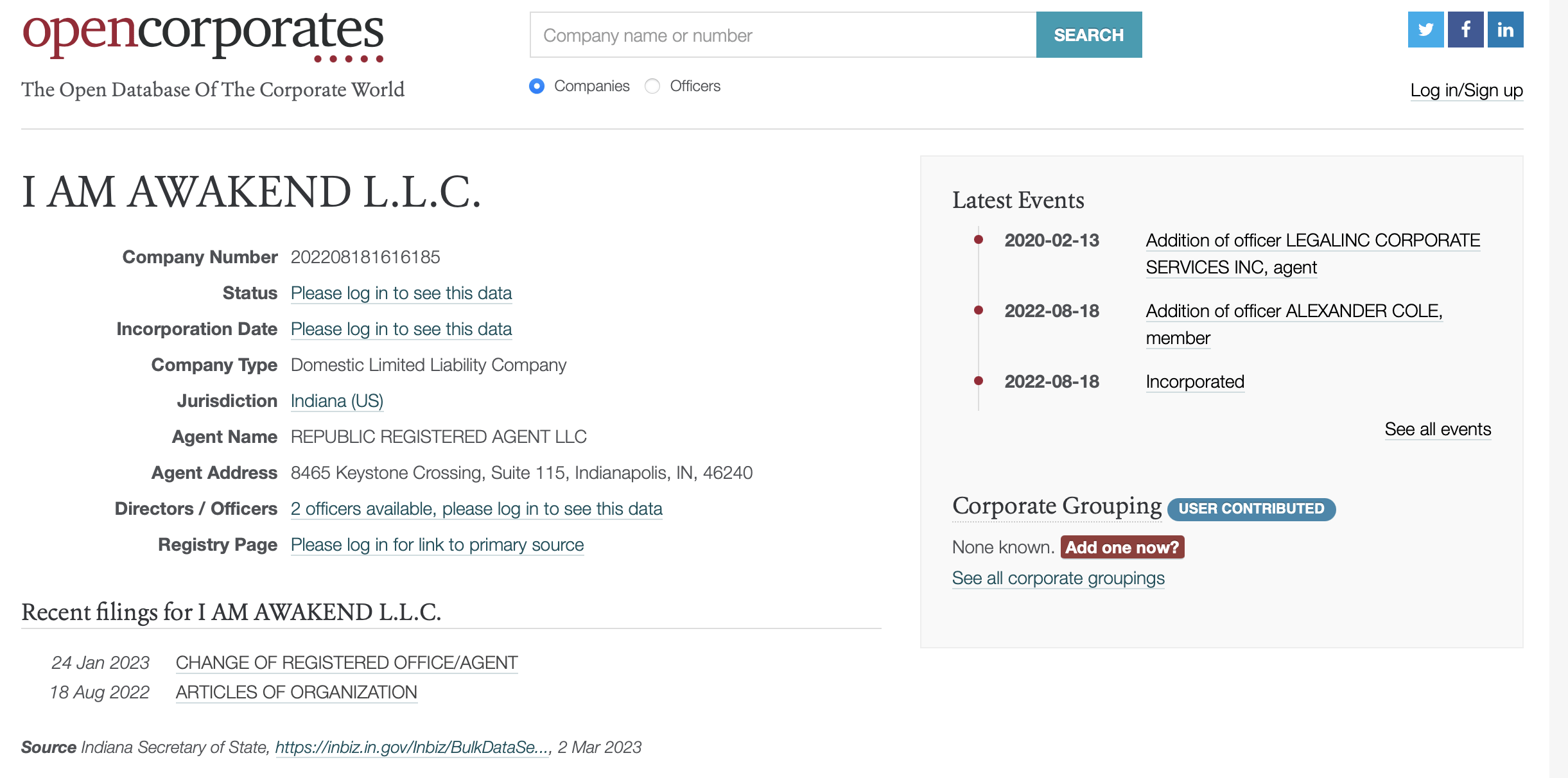

FULL CLAIM: “Is there a new plandemic on the way”; spikes in illnesses in New York and China aren’t airborne; chlorine and benzene in food and water are responsible for respiratory illness spike
REVIEW
A video published by the YouTube channel “I AM Awakened” at the end of December 2023 questioned a spate of illnesses in China and New York, claiming that this was caused by chlorine and benzene in the food and water. The video also added that the rise in illness couldn’t be airborne, as people could only be sick due to contaminants in food and water.
The video was also posted on the corresponding Facebook page “I AM Awakened”, where it received more than 210,000 views. The page has nearly 280,000 followers. The page’s creator also runs an online shop selling crystals and stones that are purported to “[protect] your energy by absorbing all the negativity”, among other things.

Figure 1 – A screenshot of the Facebook page “I AM Awakened”, which has received roughly 70,000 likes and 279,000 followers.
The language in the video signals a conspiratorial tone, displaying from the get-go the text “Is there a new plandemic on the way”. The word “plandemic” is commonly used by those who believe the COVID-19 pandemic was planned. One of the most memorable vehicles of COVID-19 misinformation early on in the pandemic was in fact the pseudodocumentary titled “Plandemic”, which Health Feedback covered extensively in this Insight article.
As we will explain below, a surge in illnesses that have been observed in New York, and indeed other parts of the U.S., as well as China, don’t signify a new pandemic, let alone a planned one. And the video’s claim that disease can only be caused by contamination of food and water is simply false.
Surge in respiratory illnesses seen in the U.S. and China due to known pathogens
A rise in respiratory illnesses in the U.S. and China made headlines on multiple occasions in December 2023, as articles from the New York Times, ABC News, and Reuters, among others, illustrate.
One notable feature was that children appeared to be disproportionately affected by these illnesses, underscored by a rise in pneumonia in the pediatric population seen in Ohio and China.
However, there’s nothing mysterious about the cause of these illnesses. Experts have explained that this observation is in line with how the winter season has historically been associated with an increased circulation of respiratory viruses, such as the flu, the respiratory syncytial virus, and common cold viruses. And since 2020, the virus SARS-CoV-2, which causes COVID-19, has also joined this group of viruses.
Mandy Cohen, the director of the Centers for Disease Control and Prevention, told the Times that the rise is linked to “upticks of known viruses and bacteria in their pediatric population.”
This is also combined with the effect of easing lockdowns. Since children were much less likely to congregate in daycare centers and schools during lockdowns, it also meant that their immune system was less likely to encounter these common pathogens and build immunity. With the lifting of lockdowns, many children were at once exposed to these viruses. Overall, this created an environment which facilitated the spread of respiratory viruses.
This phenomenon, called “immunity debt”, was more marked in China due to the longer and harsher lockdowns compared to other countries, scientists told Nature.
In brief, scientists attribute the surge in respiratory illnesses seen in the U.S. and China to a combination of factors: the typical spread of respiratory viruses associated with the winter season and the reduced level of immunity to these viruses, as a result of COVID-19 pandemic measures. Scientists have found no novel pathogen involved in these cases, and the claim that this is a prelude to a pandemic is unsubstantiated by evidence.
Chlorine compounds and benzene can occur in food and drinks, but in small quantities that are safe
The video’s claim that people can only get sick from contaminants in food and water is grossly inaccurate. As the section above illustrates, infectious agents like viruses and bacteria are a common cause of illness.
The video highlighted chlorine gas and benzene in food and drink as the culprits behind the respiratory illness surge. Again, this is false as the evidence has singled out viruses and bacteria as the cause. Moreover, while chlorine compounds and benzene can occur in food and drink, there’s no evidence that the amounts they are present in are harmful.
Chlorine is a component of antimicrobial compounds that are widely used in the food industry to kill bacteria on fresh food that could pose a health threat to consumers. One example is Salmonella from poultry and eggs, which can lead to severe illness and even death. Both animal and plant-derived products can be cleaned using chlorinated wash water. In addition, chlorinated products are also used to sanitize food processing environments.
The U.S. Food and Drug Administration (FDA) specifies that chlorine, as an antimicrobial agent in water, “may be safely used in food” in amounts not exceeding three parts per million (or three milligrams per liter of water) residual chlorine dioxide. Additionally, fruits and vegetables that are washed in this manner are either rinsed using potable water or further processed by blanching, cooking, or canning.
Chlorination is also used to kill microorganisms in water that can cause disease and is a critical part of maintaining safe public water systems around the world.
The World Health Organization’s Guidelines for Drinking-water Quality states that chlorine shouldn’t exceed five parts per million, while chlorate and chlorite, two chlorine-containing compounds that can arise as by-products of chlorination, shouldn’t exceed 0.7 parts per million.
In the European Union, the quality of water intended for human consumption is regulated by law. Under this law, chlorate and chlorite levels aren’t permitted to exceed 0.7 parts per million when chlorination is used as a disinfection method in the public water system.
The U.S. Centers for Disease Control and Prevention states that “Using or drinking water with small amounts of chlorine does not cause harmful health effects and provides protection against waterborne disease outbreaks”. The U.S. Environmental Protection Agency has set a legal limit of four parts per million of chlorine in drinking water, a level “below which there is no known or expected risk to health”.
The video claimed that consumers were being exposed to chlorine gas from food and water, but this is simply unlikely. Pure chlorine is highly reactive to water and oxygen. As such, people are much more likely to encounter chlorine in the form of chlorine compounds rather than pure chlorine gas.
Indeed, the form of chlorine most people encounter is chloride, which is omnipresent in food as sodium chloride, or ordinary table salt. Chloride in itself isn’t harmful. In fact, it plays an important role in biological processes, such as muscle contraction and the regulation of body pH and digestion.
As for benzene, it is a chemical that can be found in car emissions and emissions from fossil fuel burning. Inhaling high levels of benzene over long periods of time can lead to cancer.
However, multiple regulatory agencies, including the U.S. FDA, Health Canada, and Food Standards Australia and New Zealand, registered health concerns provoked by benzene due to the fact that it can also appear in beverages. This affects beverages that contain certain ingredients, namely benzoate salts and Vitamin C or erythorbic acid (a close relative of Vitamin C), due to chemical reactions between these compounds. Benzoate salts and Vitamin C can occur naturally in certain fruit like cranberry. They can also be added to beverages as preservatives in order to inhibit the growth of microorganisms.
To address this concern, the Center for Food Safety and Nutrition, a branch of the FDA, conducted a survey of nearly 200 soft drinks and beverages from 2005 through May 2007, measuring benzene levels in these drinks[1].
The survey found that the vast majority contained less than 0.05 parts per million benzene—the EPA’s legal limit for benzene in drinking water. Only a small number exceeded this limit, and those identified as such were reformulated and then tested. These reformulations were found to contain less than 0.015 parts per million benzene, well below the EPA’s legal limit. The FDA continues to test for benzene in soft drinks and beverages to monitor this problem.
Health Canada and Food Standards Australia and New Zealand also conducted surveys of their own. Both also found that by and large, the level of benzene in soft drinks and beverages was very low and as such, the health risk posed by this exposure was small.
Delving into the identity of the video’s creator
Apart from YouTube and Facebook, the channel creator also has a presence on TikTok under the username “iam_awakend14” and on Instagram. The Instagram bio describes him as a “Spiritual leader and indigo star seed sent to bring a message”.

Figure 2 – Instagram bio associated with “I AM Awakened”.
Additionally, the YouTube channel lists another associated Facebook page named “I AM Awakened 2”, currently with more than 114,000 followers.

Figure 3 – The Facebook page “I Am Awakened 2”, with more than 16,000 likes and 114,000 followers.
Despite the relatively large following that these social media accounts have, none of them identify the channel’s creator by name.
Using the email address listed on the YouTube channel and the page “I AM Awakened 2”, we conducted a search on Epieos, a tool which enables one to view public information associated with an email account. This led us to the name “Alexander Cole”.

Figure 4 – Epieos result for the email address associated with the YouTube channel and Facebook page.
On OpenCorporates, a limited liability company, I AM Awakend LLC, lists someone named Alexander Cole as a member of the company.

Figure 5 – Information on the company I AM AWAKEND LLC. On the right, the page indicates the addition of the officer Alexander Cole to the company.
We reached out to the video creator using the email address listed on the YouTube channel and will update this review if new information becomes available.
Conclusion
A surge in respiratory illnesses in the U.S. and China is due to known pathogens that circulate more widely during the winter, such as the flu, RSV, the common cold, and COVID-19. Experts don’t consider this surge as the sign of a new pandemic, contrary to the video’s claim.
While chlorine and benzene can occur in food and drink, they aren’t the cause of the respiratory illness surge. Both chlorine and benzene are regulated chemicals in food and drink. Chlorine-containing compounds are common antimicrobial agents used in the food industry to kill harmful bacteria and improve the safety of food products. Regulatory agencies have established guidelines for the use of such compounds in order to maximize their benefits while minimizing their risks.
Benzene can occur as a result of naturally-occurring compounds in soft drinks and beverages. Regulatory agencies in the U.S., Canada, New Zealand, and Australia have conducted tests on soft drinks and beverages; all found that benzene levels were generally well within safe limits and don’t pose a threat to health.
Ultimately, it’s telling that the video begins with its creator distancing himself from his claims early on, telling his viewers “this is for entertainment purposes only” and that “I am not a medical practitioner, a doctor or anything and you should not be taking medical advices(sic) from me”.
REFERENCES
- 1 – Nyman et al. (2008) Survey Results of Benzene in Soft Drinks and Other Beverages by Headspace Gas Chromatography/Mass Spectrometry. Journal of Agricultural and Food Chemistry.


